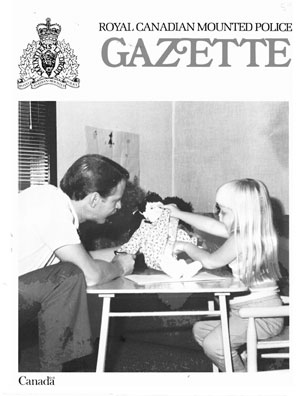

Canada
ROYAL CANADIAN MOUNTED POLICE
VOL. 50, No.3, 1988
ROYAL CANADIAN MOUNTED POLICE
VOL. 50, No.3, 1988
CHILD SEXUAL ABUSE
by Cpl. Hunter McDonald,
Victoria RCMP Sub/Division G.I.S.,
Victoria, B. C.
Victoria RCMP Sub/Division G.I.S.,
Victoria, B. C.
PAGE 1 PAGE 2 PAGE 3
Introduction
Child sexual abuse has finally been recognized as a much larger issue than previously thought. Training for the investigators of such crimes is an area that is being addressed amidst a controversy over the necessity for developing generalist vs. specialist skills. This article deals with issues concerning support of the victim, rights of the suspect, investigation and prosecution. It should be borne in mind that the American experience indicates that lawsuits against investigators, prosecutors and counsellors are emerging and that we, in Canada, must be prepared for the backlash that is already being reported in the media.
[ TOP ]
Child Sexual Assault - Definition
In B.C., the accepted definition of child abuse is derived from the Family & Child Services Act, and includes "any sexual touching, sexual intercourse or sexual exploitation of a child and may include any sexual behaviour directed toward a child.
For my purposes, I will refer to chronic (long term) assault as sexual abuse and the more violent (or, once only) offence as acute or sexual assault. Approaches to both types of complaints differ slightly, especially in the speed and order in which the process is conducted.
[ TOP ]
Public Concern
Many of you, I am sure, are aware of several major reports that have been published and debated - the most notable of which is the Badgely Report. This 1984 Royal Commission surveyed the problem in Canada and brought to light some disturbing statistics: that one female in four and one male in ten prior to the age of 18 had a sexually inappropriate experience.
Statistics may indicate the magnitude of the problem but, no matter what the total number of offences, any offence is, for the victim and family, a traumatic experience. It follows that our investigation must be sensitive, objective and thorough.
There was a recent high profile case in British Columbia in which a school teacher, Robert Noyles, was found to be a dangerous sexual offender. This case raised the ire and awareness of the public, especially parents. This case, and many others like it, have also raised the issue of protection for persons being accused. Recently, some members of the legal profession have suggested that an accused should not have his or her name published unless a conviction is registered.
As police officers, we are well aware of the delicate balance between the rights of the accused and those of society. By and large, our criminal justice system is fair. However, what if you, as a police officer, were accused of sexually assaulting a person? What protection would you have? What can such accusations do to your reputation, your marriage, your career, your self esteem? Obviously, it can be devastating to a person to be wrongly or maliciously accused. It is crucial that we, as objective investigators, be aware of and sensitive to the needs of all parties.
[ TOP ]
Personal Assessment
As with other areas of police investigation, not everyone is "equipped" to deal with child sexual assault complaints. You should ask yourself the following questions:
- "Do I have the right attitude, skills and interest?
- "Can I cope with the pressure of continuously dealing with an emotionally charged crime?
- "Will I burn out?
- "Can I be empathetic yet objective?"
If, in answer to these and other self analytical questions, you can say, "Yes, I want to do this type of work,", then the next step is to gain the knowledge of the dynamics of victimization and to sharpen your skills in dealing with pedophile suspects.
However, because of personnel requirements, changing shifts, and 2 varying sizes of departments and detachments, you may not have a choice in whether or not you conduct these types of investigations. Fortunately, most police officers can change mental gears when the need arises. Indeed, the ability to disconnect (or disassociate), then reconnect, is a key to our emotional survival and effectiveness as police officers. The issue of "burnout" is not new to us. Yet, when interviewing a four-year-old girl who has been abused by her dad, we need empathy and compassion when dealing with victims and sometimes even with suspects. That is not always easy to do.
Certainly as this article unfolds, the question may be asked, "Can we expect every officer to gain the insight, knowledge and experience to be effective in this field of work?" Effective listening and communication skills, coupled with a sense of humour, are appreciated by victims. Lastly, the question must be asked, "Why do I want to do this? Is it because I am a victim or am related to one? Am I too close to the problem to be objective." Only you can answer these questions.
[ TOP ]
Police Deployment
The following are possible approaches depending on personnel availability and situation.
- In small or mid-size municipal agencies or RCMP· detachments, the selection of a core of suitable and trained general duty members is often beneficial. After all, in . chronic abuse cases, an urgent response is often not required unless protection of the child's life is an issue. In non-urgent or chronic cases, the complainants can be contacted and advised when the designated officer will next be on shift. They can also be given support material and the names of resource persons prior to the beginning of a criminal investigation. In sexual assault (urgent) cases, time is of the essence and the normal procedures would apply.
- A plainclothes general investigation section can be:
(a) Crime Against Persons Unit handling homicides, all assaults, sex crimes, spousal assaults and abuse of the elderly.
(b) Crimes Against Property developing expertise in all robberies, arson, frauds, break and enter, etc.
Such a split allows officers to develop the expertise required within their area and streamline investigations. - The formation of a
Sex Crime Unit specializing in child-related offences but also dealing
with pornography and prostitution is another option and ideally,
involves teams of police officers and social workers (a male and
female if possible) who handle the complaint right through to
prosecution. The skills and attitudes that a highly-motivated team
bring together ensures that all areas of concern are addressed,
including the objective and victim-supportive gathering of evidence for
prosecution.
Working out of the same office enhances communication and helps to break down inter-agency stereotypes. Expertise increases as each discipline is exposed to the other. The flow of an investigation allows for joint interviews of the victim, followed by the social worker continuing to work with the victim, by interviewing school teachers, counsellors and other knowledgeable persons, and finally by setting up therapy and court preparation. The police officer would follow up on finding and arresting the suspect. Both would then contribute to the court brief. Such a team can remain active in supporting the family right through till disposition of the case. If the family still requires assistance after court, the family would be referred to a regular social worker office.
As each manager decides on the format that fits his or her agency's situation, it is paramount that the issue of "burnout" be addressed when seeking volunteers. A maximum time limit R.C.M.P. GAZETTE of two to three years may be necessary.*
[ *It is possible that the reader could be mislead into believing that burn-out is directly related to length of service.in a particular duty. Burnout is not necessarily prevented or resolved by placing a time limit on the number of years served on any particular duty. There are numerous environmental and personal factors, which, if addressed, could prolong service without any appreciable burn-out. Ed. ]
[ TOP ]
Network Protocols
In our everyday work we use resources and contacts to assist us. They come from many sources. Too often the old cliches about social workers, mental health professionals and others place obstacles in the road to effective teamwork. Similarly, many other professionals hold stereotypical views of police officers.
British Columbia has incorporated into the Inter-Ministerial Child Sexual Abuse Policy Handbook the concept of doing what we already do in many other "areas of police work; that is, meet on a regular basis with other concerned parties. An open exchange of information, in a' confidential and supportive atmosphere, between social workers, prosecutors, physicians, public health nurses, school counsellors, and mental health employees, ensures that manipulative suspects do not fall through the investigative cracks. A face-to-face exchange between all involved parties is the main benefit.
Such meetings can be split into two parts, the first intended to share general non-confidential information regarding new techniques, studies and protocols, involves all persons mentioned above. The second, more confidential case-related part, can be just between social workers involved in current cases, police and prosecutors. I cannot stress enough the improvement in understanding gained by all parties into each other's roles and expectations.
The formation of structured protocols in each area, accompanied by lists of key personnel, is the most effective way to give service to the community. A package including names and phone numbers of key local agencies and personnel, along with an outline of the procedures the victim(s) should expect, is appreciated by families. It has been my experience that burn-out can be reduced by developing specific protocols and networking as doing so allows "helping" professionals to feel less isolated and overwhelmed by the immensity of the tasks faced.
[ TOP ]
Male and Female Teams
On occasion, you may hear that sexual assault is a "feminist" issue. However, on the street, it rapidly becomes clear that it is a "people" issue. While most of the offenders are male and a high percentage of victims are female, a significant number of victims are male and more than the occasional offender is female. It follows that the attitudes, insights and abilities of the investigators are fundamental to obtaining accurate disclosures. The gender of the investigator is not the key - professionalism is.
However, a male and female team sends a subtle message to the victim - that not all men are bad. Such a team gives the child a positive set of role models to assist in the healing process, at a time when he or she needs to be able to trust again. If the child does not feel comfortable in the presence of one of the interviewers, that one can leave to facilitate communication. Many women, especially in the counselling professions, can establish a rapport with a young child which will continue after the initial disclosure.
It is particularly important when dealing with adolescent victims of homosexual attacks that the victim's desires regarding gender of the interviewers be considered.
[ TOP ]
PRIMARY VICTIM
It is easy for us to see the immediate results of property offences. Usually, an insurance policy will assist the victim in recovering from the financial loss. However, the victim's sense of frustration, of having been violated cannot be readily seen by the officer. A violent assault is documented on the court brief. Photographs and medical reports catalogue the injuries. Usually, an adult victim will eventually articulate the appropriate feelings, may seek therapy, and will probably reach out for help. On the other hand, young children do not know how to cry out for help. They may not have the words or understand what is causing them to feel badly. They may be scared to tell. In short, if they cannot articulate, they may "act out". (See Appendix).
When a person in a position of trust or power sexually violates a child, several things result. A breach of trust (a key element in a relationship) occurs and a "secret" is created. The power to reward or punish is invoked and used with devastating effect in some relationships, for example, teacher and pupil; step-father and child. When a parent or relative offends, the effect is lifelong. The special relationship a child had with "Mom" or "Dad" is destroyed forever. Many victims suffer well into midlife because of the unresolved feelings. These feelings translate into behaviour problems in adolescence and into relationship issues in adulthood.
We, as investigators, should not be surprised if the child refuses to open up. The longer the time over which the offending has occurred, the more patience will be required. Before anything can happen, a bridge of trust must be built between the victim and the professional. Many contacts may have to be made before a disclosure is given. The needs of the victim must be uppermost in our minds. The loss of power and control over their own needs and bodies has been removed by the offender. We must return control to the child and offer choices, albeit very focused ones.
[ TOP ]
Mixed Feelings
When a child is victimized by a parent, relative or person in a position of authority or trust, a complex set of emotions is created. The natural love or respect for the offender is still there, however the victim knows something is wrong and may not be able to 3 separate the emotions into easily described feelings. A child may love someone but not like what they are doing. On the other hand, a female victim of incest who may have "replaced" Mom may like the attention and reward's that go with allowing such abuse to continue. Fear, embarrassment, guilt, and hate are usually layered under the surface and must be patiently peeled away by the interviewer before a full disclosure can be obtained.
The guilt which a child can be made to feel if the offender loses his/her job or goes to jail is inappropriate. Jealousy, angry relatives, public embarrassment and break-up of the family can cause the victim to be ostracized or intimidated into not proceeding with the initial disclosure. Loss of family income provided by the suspect can also be a major issue causing the child to withdraw or recant a disclosure.
In addition, the child may enjoy the sexual feelings aroused by the fondling and this may conflict with the subconscious feeling of not liking it. He or she may get messages from helping professionals that he/she was not supposed to like the "feeling". This may increase the guilt and prevent a full disclosure. We must not run down the offender as the child may still have positive feelings for him or her. We can, euphemistically, say that the adult has a "touching problem" and it is his/her fault, rather than the fault or responsibility of the child.
[ TOP ]
Male Victim
If the offender is male, the male victim then has the stigma of homosexuality hovering over his head. His sexual identity comes into question, posing several immediate dilemmas:
- Why me, am I gay?
- I am male, I am supposed to be strong, I should have stopped it.
- The general perception is that homosexuality is unnatural and, therefore, I must be bad.
[ TOP ]
THE SECONDARY VICTIM
Recognition of the damage to non-offending parents, family members and friends must be borne in mind. How many times have we heard a father state, "If anybody ever touched my children, I would kill him." We cannot afford to ignore these statements or feelings that might not be stated. We must recognize that in most cases anger, frustration, fear and lack of knowledge, will hinder the investigation. The non-offending parent must be seen as a victim and dealt with accordingly for three reasons:
- a) The child needs a loving, supportive and consistent home environment to assist the healing process. This cannot happen if uncontrolled anger still abounds in the home.
- b) We must prevent the occurrence of a serious criminal offence against the suspect. This only compounds everyone's problems.
- c) We must recognize the genuine sorrow and loss of dignity caused to parents by the violation of their offspring and breach of their own trust by the suspect, whether spouse, friend, teacher or babysitter.
Reading material and information must be offered to the family members to assist them in facing the trauma of the disclosure, the counselling and the possible criminal and custodial actions that may follow.
Also, many non-offending parents may themselves have been victims and may have not yet dealt with their own abuse. These parents will have to be counselled concurrently with the work being done with the child, preferably by the same counsellor.
[ TOP ]
 The author, a native of Scotland, emigrated to Canada
in 1965 and
joined the St. Boniface, Manitoba, Police Department the following
year.
The author, a native of Scotland, emigrated to Canada
in 1965 and
joined the St. Boniface, Manitoba, Police Department the following
year. He joined the RCMP in 1969 and has worked general duty detachments, a highway patrol unit and marine services. He also participated in the E. R. T. programs, was a team leader for several years and has been a shift NCO and a detachment commander.
Cpl. McDonald lectures in the areas of cross-cultural education as well as child sexual assault and has done so for both the RCMP and the Justice Institute of B.C.
You may contact the author at:
inquiries [AT] childsexabuse.ca